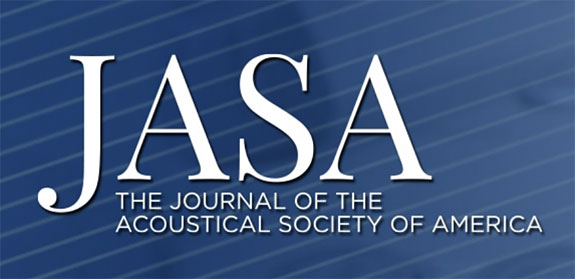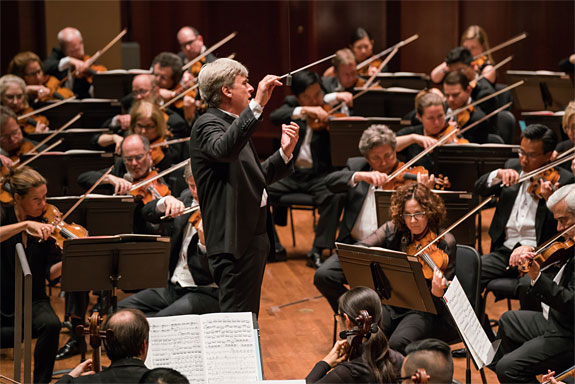|
|
Home | High-End Audio Reviews | Audiophile Shows | Partner Mags | Hi-Fi / Music News |
|
|
|
30 Years Of Service To Music Lovers |
|
|
The Wrong Thing
Hi-fi and the sound of real music.
Article
By Roger Skoff
For many years, imaging and soundscaping have been my primary criteria for judging the sound of recordings and the equipment we play them on. I can remember being thrilled and truly excited about the (Avalon) speakers I was listening to and about the room that I was listening in when I first heard the original cast recording of 42nd Street [RCA CD RCD1-3891]. I was sure, sitting there, that I could not only hear and physically "place" the sound of each tap of the heels and toes of a whole chorus line of dancers. I could also hear the dancers moving right or left and even "see" the whole chorus line pivoting, Busby Berkeley-production-number-style, on the delineated soundstage, while a pair of tap-dancing soloists moved in front of and around them.
That was a truly spectacular and memorable event, and as "real", in my mind's eye, like anything else, I can ever remember. The only problem was that that's not what a live performance sounds like.

Another audio incident I remember — although, after all these years, I can't recall either the name of the singer or the recording — was when, at the home of my friend, Bill Tomori, we were listening to a "live" recording of a girl singer performing with a big band on his top-of-the-line Apogee ribbon speakers, powered by Cello electronics driven from a Goldmund Reference turntable with a Koetsu Rosewood cartridge. The sound was so good that you could easily tell that, although the band and the singer were both performing at the same time, the singer had been placed in an isolation booth to give her voice more separation from the band backing her up, and you could hear the two acoustic environments — the main recording venue, with all its size and natural ambiance, and the smaller, deader, confines of the isolation booth — as the song played on.
Again, spectacular, but that's not what real music sounds like.
Finally (at least for this article), there was the time that I was at Tony Di Chiro's house — formerly President and Chief Designer for Kinergetics, and most recently (as I recall) Director of Research for Monster Cable — and after we had listened to a terrific piano recording, I commented to him that the sound was really good, but that the piano didn't sound "piano-size". When he asked what I meant by that, told him that the piano in the recording didn't seem to have any "edges" to define its actual size or shape, and that I thought it ought to.

In answer, he went to another room, brought out his acoustic guitar, briefly tuned it, and played a few bars of music. To my great surprise, that real instrument, playing in his good-size but not huge living room, didn't sound at all guitar-sized but filled the room with its sound — something that, until then, I would have criticized if I had heard it recorded and playing on a stereo system.
The fact of it was that I was — and, I suspect, most of us often are — listening for (and judging our systems by) the wrong thing.
I was talking about this recently with my friend, Tom Miiller, a former reviewer for, among other things, the absolute sound, and we came to largely the same conclusion: We are expecting the wrong information from our very best systems, and often losing the real sound of the music in the process.

The fact of it is that, whether in a concert hall, a small jazz club, an intimate chamber music salon, or in the biggest stadium or outdoor venue, live music doesn't "image" anywhere near as well as our best audio systems. You can't, with your eyes closed, count the number of rows of violins in a symphony orchestra, or how many instruments are in each row. You can't, as a marching band passes by on the street in front of you, clearly identify — unless you look at it — the position of each of the musicians. On the Midnight Sugar album [FIM SACD 035], a good stereo system in a good room will let you almost "see" the moving fingers of Tsuyoshi Yamamoto as he plays jazz piano, unless you're looking directly at his hands at a live performance, you won't be able to "see" them at all, and the sound of the piano will be that of the whole instrument, and not locationally highlight any individual key, or even tell you which side (right or left) of the instrument it's on.
What we have come to do in High-End audio is to expect to get visual information — exactly how big an instrument or performer is, where it's located, in how big and what-shaped a room or venue, and how it is placed relative to which and however many other performers or instruments may be present — from an auditory source. That simply isn't how real music sounds, and, to the degree that we can sometimes actually do it, may very well not be an aspect of the music, itself, but of the recording and playback process.

Much of our ears' ability to locate sounds depends on the "Haas Precedence Effect" — which can be described most simply as our ability to tell which sound arrives at which ear first.
To illustrate this, let's first say that a sound arrives from directly in front of us. Both ears will hear it at the same time and we will, therefore, be able to identify at least its direction of arrival, though not necessarily its distance. If the sound arrives directly from our right, our right ear will hear it first, followed, later (because of the distance from one ear to the other) by the left ear, and we will know that it came from the right of our listening position. For other source positions, one ear (the closest) will always hear it first, with the second ear hearing it delayed by an amount of time equal to whatever the difference in distance between the source and the two ears may be, times the speed of sound.
Where this may be important in examining the relative imaging ability of live music and a good recording / playback system is that, in listening to "live sound", we always use our ears directly (normally about 5" apart), but recording microphones and playback speakers; the things that pick up the sound and play it back to us may be (and in the case of speakers, must be) at entirely different distances apart. This can result in perceived directionality and imaging far beyond that of our ears.

So can the use of multiple microphones (including "ambiance" and "spotlight" mics) instead of just the two ears we have naturally, special effects electronics, and multi-track "lay-up" recording techniques; all of which allow recording engineers to create whatever image or soundstage they may prefer. Many recordings make heavy use of such techniques, and some, which may never have any one "live" recording session at all, combine all of them to give a recorded sound with potentially far better spatial and imaging characteristics than any live musical experience could ever provide.
In short, our attempts to reproduce sonic reality may be giving us something that isn't real.
Many years ago, when we were both reviewers for high-end audio magazines, Tom Miiller and I agreed that the one characteristic that must override all others in judging a recording or a piece of equipment was "believability": Could we believe that we were listening to real music. Now, in our recent conversation, we've come around to thinking that "presence" — the feeling that, even though there may be no perceivable image or soundstage at all, you can still feel and instinctively know its reality — is even more important. You've probably experienced this yourself.

You know; like when there's live music coming from somewhere and, even though you don't know from where, you still know for certain that it's live. You may also have, as have I, experienced the opposite: Like the time, fairly recently, when I heard a truly wildly expensive state-of-the-art system that imaged like two mothers and a partridge in a pear tree, but still didn't feel real at all.
I now know that the imaging and soundscaping that used to be among my prime listening criteria are not necessarily the reality I that I once took them for. Even so, I'm still going to enjoy them and keep them high on my list of things a great system must do. I also know that real bass is often not even heard, but just present as a sense of power behind the music, but that doesn't keep me from grinning from ear to ear when some wondrous deep drum crash or pedal note makes me feel like it's going to crush my head or throw me clear across the room!
It's all part of the music, and I truly...
Enjoy the music!
Roger Skoff

 High-Performance Audio Reviews
High-Performance Audio Reviews














